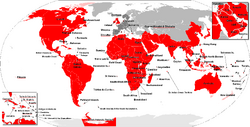The English Imperial Republic (also referred to as the English Republic, the E.I.R, and the E.R) is an Imperial Republic comprised of colonies in Africa, Asia, North America and Parts of South America.
History[]
In 1605, the reign of King James I came to an end with the Second Glorious Revolution and the destruction of the English throne. The working class soon seized the moment to change the government for the people of England and beyond. In the Leeds Conference, it was decided that the new government would be headed by a President serving as the head of state while a Prime Minister.
Though the Republic was less oppressive, the English Republic continued its aggressive expansion into the early 20th century.
Government and Elections[]
The English Imperial Republic is one of the first and oldest Imperial Republics in the modern world. It is a constitutional republic and a representative parliamentarian democracy. The government is regulated with a series of checks and balances defined by the Constitution. In the English Federalist system, citizens are usually subjugated to four levels of government Federal, Commonwealth, Provincial and local.
The English Imperial government is comprised of three branches:
- Legislative: The legislative branch is comprised of a bicameral legislature. The first section is known as the Senate, in which 4 senators, no matter the population, will represent their colony. The Senate is headed by the Deputy Prime Minister. The House of Representatives, the largest half of the legislature has the colonies representing them depending on their population. The House is headed by a Speaker.
- Executive: The executive branch is comprised of two leaders. The President performs most of the ceremonial duties, including being head of the armed forces, vetoing bills and appointing members of the Judiciary.
- Judicial: The judiciary consists of a Supreme Court Justice and eight associate justices. Members of the judiciary are appointed by the President and the Prime Minister. The Supreme Court Justice is to serve at least until the age of eighty.
Constitutional Amendments[]
- Amendment 1: Freedom of Speech, Religion, Press, Assembly, and Protest are Protected
- Amendment 2: Right to bear arms.
- Amendment 3: Slavery is made illegal.
- Amendment 4: Right to privacy: No unwarranted search and seizures, and no quartering of soldiers in private homes.
- Amendment 5: Right to a speedy public trial with legal counsel, with no double jeopardy, and ensures a trial by a jury, and rights of the accused.
- Amendment 6: No cruel or unusual punishment, or excessive bail.
- Amendment 7: Trial by jury for civil cases.
- Amendment 8: Reserved Rights to the Commonwealths.
- Amendment 9: Any rights not mentioned are rights of the people.
- Amendment 10: All rights in the Bill extend to every Citizen of the republic.
- Amendment 11: Authorizes apportioned federal taxes on income.
- Amendment 12: Abolishes slavery in the Republic
Parties, ideology, and politics[]
Economy[]
Income and human development[]
Science and technology[]
Transportation[]
Demographics[]
Language[]
Religion[]
Education[]
Health[]
Crime and law enforcement[]
Political Divisions[]
As an effective means of governing, the colonies were divided into several self-governing commonwealths comprised of several states.
Commonwealths[]
North America[]
- Eastern America
- Western America
- Southern America



